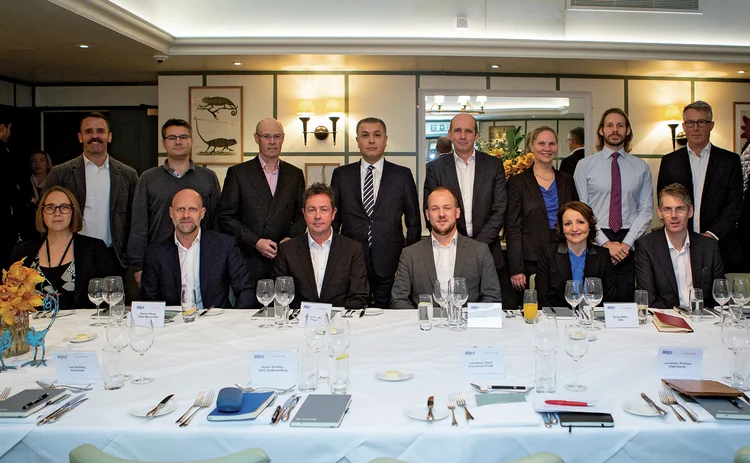
This article was paid for by a contributing third party.

Roundtable: Building out from the back office

To what extent are insurers and brokers being held back by legacy back office systems? And what and where are the most notable pain points?
Darren Sharp, group head of IT, Tokio Marine Kiln: What is holding us back is perhaps more the culture than the technology. We don’t have a massive amount of technological debt other than some old claims and policy administration systems.
Jonathan Phillips, head of IT and change, CNA Hardy: There’s a question in my mind as to what legacy means? So, at what point does something become a legacy system? The systems from the 1960s, 1970s or 1980s? There’s a sense that many firms are trying to wrap these legacy systems up so we don’t actually have to change them. And to be fair some of these older legacy systems are pretty stable. They don’t really fall over.
Ronan Hanrahan, director of operational transformation, QBE: I would characterise it as a complexity problem. The various systems in themselves are not challenging. But we have so many of them that the interfaces between them create a spaghetti junction type mess. It’s that complexity that’s holding us back, not the inherent systems themselves. We can either simplify things by reducing the number of systems – eliminating some rather than looking to replace them all – or going for the whizz-bang major overhaul.
Donna Willis, chief operating officer, ERS: If you have got various platforms then you have got to stitch the data together from all these sources to properly understand the customer experience - or make decisions as a business. So, you’re going to struggle if you’ve not got fewer systems. It doesn’t matter how old they are, it’s the volume and the capacity that presents the issue.
John Davison, chief information officer, First Central Insurance & Technology Group: The key is data. Having one system [not lots] facilitates a single view of a customer, which is important if you are going to provide a proper digital experience. All the advantages of being able to change quickly come as a by-product of that.
Quinton Goddard, data and AI advisory lead, Avanade: A lot of financial services firms have encountered regulatory issues which require technology solutions. And those have often been bolted onto the existing IT systems. Then there’s a reluctance to change anything that relies on that system for fear of breaching the regulatory requirement that saw it introduced in the first place.
Hanrahan: Insurers in commercial markets from corporate to SME don’t have the same scale [of legacy] that the banks would have. The economics of outsourcing be it technology or back-office functions are also slightly different. But the distribution channels that we have, be it in the company market or Lloyd’s, are very different. Relationships built on complex interfaces between the external world, such as brokers, and our own internal systems.
What can IT departments/CIOs do to make back office technology upgrading a greater – or at least as much a priority – as that of the front end interface with customers?
Kevin Findlay, chief technology officer, CFC Underwriting: If you put in a new system and don’t get the buy in of your underwriters you might not get the efficiency gains you had hoped for. Your internal systems should offer the same quality as an end-user experience. It is then a choice about which ones you release to the front end. If we’re selling business-to-business and to brokers, we want to make their lives as easy as possible and not for them to fill in a million forms just to get a quote. It’s important we develop that in-house and then give them that capability.
Eva Berg-Winters, CEO, Bewica: You need to be on a journey where there are all kinds of small savings that you can realise with the full support of the different teams involved as long as you enable them to see the opportunities. When you energise the people who are impacted, the ones who will actually see the benefits, then you will get the best results.
Davison: The benefits case has to be borne by the business not by your IT function. Your IT function, by itself, will never deliver any operational savings in your fraud department for example. Each department has got to want to improve their processes and become more efficient so that you can write more volume or reduce costs. You’ve got to bear that cost across the business and be transparent. I have a challenge with the definition of back office. Internally we used to refer to the front-end as being our web or customer-facing systems, but if every single business process is available to your customer then do you have a back-office? We’re now in a position where we may elect to move a transaction online or make it available via an app which removes the separation between front- and back-office. We don’t go through a process of replacing a back-office system -but a process or capability instead.
Willis: IT departments are there to enable and support the business. In terms of the business decisions and choices; that has to come from the executives and be communicated top-down. You can’t expect an IT department to be shaping that strategy. To sell it to the board you’ve got to talk to them about growth, profitability, and all of the drivers around that. The word ‘translation’ is key. Working between what the executive are looking to achieve from a strategic perspective and then being able to translate that from an IT outcome. And when you can translate it, you get the engagement and the buy-in.
Jacob Abboud, chief information officer, Allianz Insurance: The fundamental solution to addressing the legacy issue is having a blueprint that enables you to future-proof systems becoming outdated in the future. If it’s underpinned with the right infrastructure model, whether it’s cloud, in-house or a hybrid system, that would enable you to build for the future.
Vanessa Dent, head of transformation, Aviva: Your systems become legacy and part of the problem as soon as they are introduced if they’re not adaptable. Our customers’ needs are changing rapidly on a daily basis, the question is then, how does that legacy or non-legacy help us adapt to those customer needs? That, for me, is part of the driver. The customer experience isn’t just the front end because the customer experience also revolves around the hand-off. Therefore, if you have a back-office system that doesn’t work, the customer facing staff utilising those systems will not be able to deliver. That’s still part of the customer experience.
Daniel Marsh, chief information officer, AIG: In my opinion, that is more of a question around the front end. The back end does not quite operate on the same dynamics because you can sit with a legacy system that’s been there 20 or 30 years and it could run a business quite happily - and it is cheap. It’s the relevance and resilience of that data too. That is how you build a business case to improve the back end piece.
Phillips: One of the business cases [for a back office overhaul] is driven by data. We all know that having access to good quality data is key. But more important is how we manipulate that data and derive value from it. That is critically important to us. When you talk to insurtech businesses, the good ones are completely besotted with the customer experience. In a way, that’s the only factor they care about. There are lessons to be learnt from that because we do not do enough of it. The conversation that you have to have is not about technology. It’s about capability.
Abboud: It also becomes a question of the strategic view of an organisation. Some organisations work in five to 10 year cycles. Some think if they don’t achieve their 10% [efficiency savings] in 18 months they will embark on a new project. What we do know is that replacing legacy systems is complex, disruptive, and expensive.
Gavin Drescher, IT delivery director, LV general insurance: The challenge is discipline. You need to be clear about what the outcome is going to be. And if it’s going to be the same system but updated for the future then that is valid, but difficult.

Would staff retention and recruitment be made better by using more intuitive and user friendly technology platforms?
Marsh: Attracting talent is really important. Ultimately, you’re recruiting technologists that want to work on the latest thing that keeps them interested. You can’t keep your staff interested if you have too much legacy technology debt.
Lee Ayling, executive advisory services, Avanade: It’s also important to remember that it is not about going to an office and sitting at a desk anymore. Often you want the same sort of technology experiences you have at home. Conversely people might want to extend their work life outside of the office too and that needs to be considered in terms of ease of use when it comes to technology they are equipped with.
Hanrahan: Getting that balance right is quite important. Recognising that we might have a 20-year-old kid just out of university at one end; and someone at the end of their career who’s quite happy to do the thing that he knows works well, at the other.
Are insurers still wedded to a 10 to 15 year cycle of change in terms of back office? And what signs are there that this is changing?
Sharp: In terms of core systems, we run a programme every single year. Anything that’s going to go [end of life] or [end of support] in the next 18 months gets supressed.
Dent: You have to be continuously iterative and showing how you are demonstrating value back to both your customers and your organisation.
Hanrahan: We get far better outcomes when we develop software iteratively and incrementally. It helps people frame what it is they really need from their business and thus they tend to get a positive result. A lot of it comes down to how you build the technology and then deploy and deliver it.
Willis: We’ve used that approach with brokers externally. So, not just internally, but building portals for brokers to log onto. Or having customers in, and them seeing something being built in an iterative way with constant testing and learning.
Drescher: And it helps when you get an injection of new talent, new ideas, and new ways of thinking. Because the technical staff are quite quick to learn. It’s all that attitude stuff. The people aspect is really important.
How has the cloud changed the purchase and integration of back office platforms?
Willis: It’s variable, depending on the type of vendor and technology.
Drescher: A lot of these vendors really have no idea about service management.
Findlay: In different geographies there are various established software vendors, and because they’re connected to the incumbent insurers and brokers they’re hard to replace.
Ayling: As a service provider, the challenge that we encounter is partnering with someone and developing in an agile way. There are certain clients where it works really well. But some will want to have fixed packages of work and price points. And so in the back-office space things can take a little longer to happen as clients want a price certainty. It’s not just the service providers, it’s also the clients.
Abboud: I certainly see an increased trend towards the adoption of cloud services or even using it for application development. You can gain some benefits from agile working. And if you couple that with development in the cloud then the potential prize is relatively big. You can get people co-located, working together across different functionalities within an organisation. And some of the feedback suggests a 50% potential increase in productivity in your application and capability development which is worth having.
Sponsored
Copyright Infopro Digital Limited. All rights reserved.
You may share this content using our article tools. Printing this content is for the sole use of the Authorised User (named subscriber), as outlined in our terms and conditions - https://www.infopro-insight.com/terms-conditions/insight-subscriptions/
If you would like to purchase additional rights please email info@postonline.co.uk
Copyright Infopro Digital Limited. All rights reserved.
You may share this content using our article tools. Copying this content is for the sole use of the Authorised User (named subscriber), as outlined in our terms and conditions - https://www.infopro-insight.com/terms-conditions/insight-subscriptions/
If you would like to purchase additional rights please email info@postonline.co.uk
